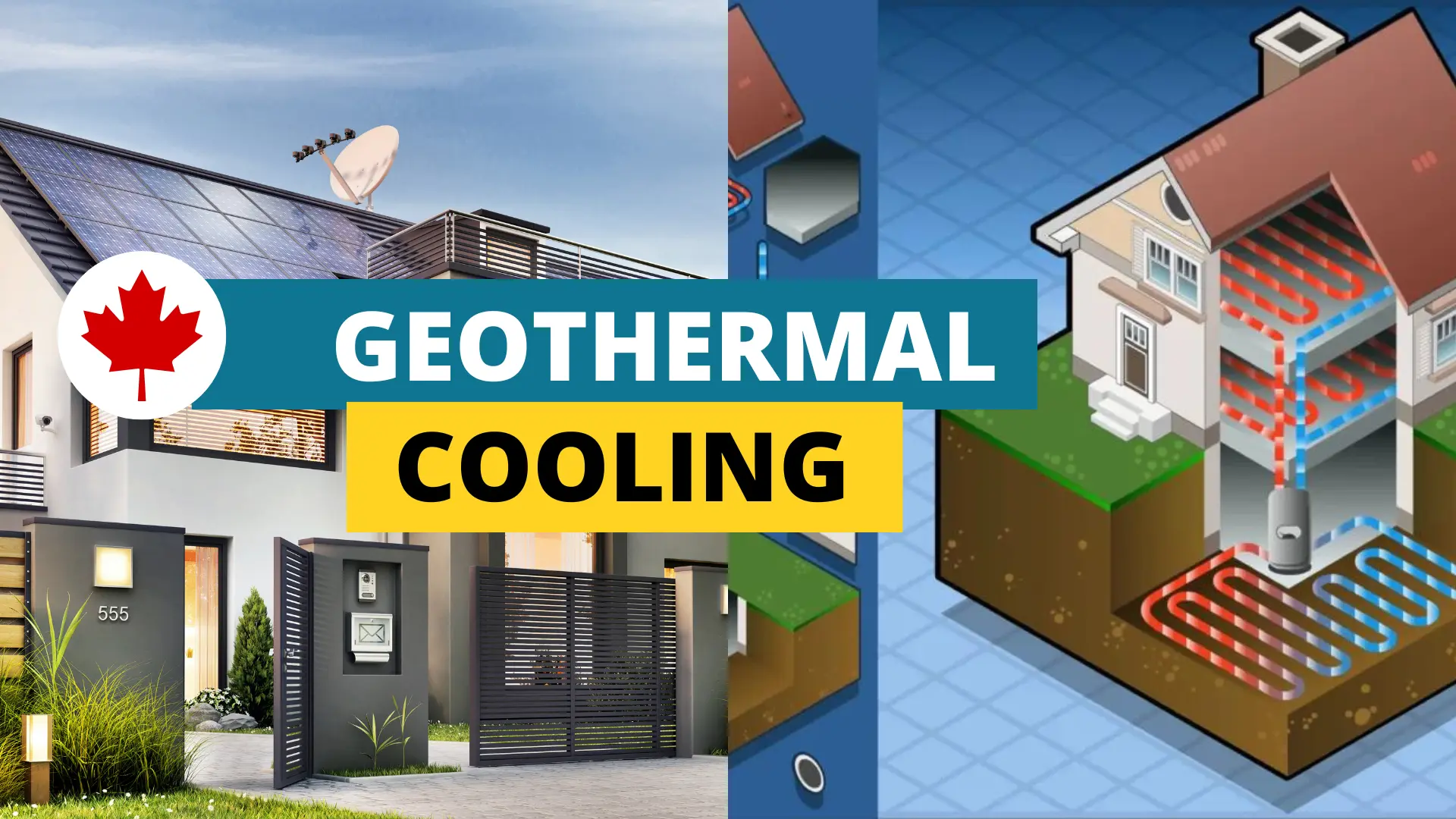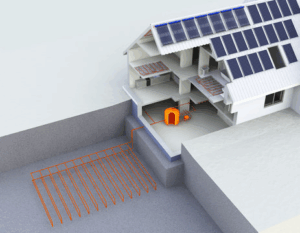As energy prices continue to rise and environmental concerns become more pressing, finding efficient and sustainable ways to cool our homes is increasingly important. One innovative solution is geothermal cooling. This method leverages the earth’s natural temperature to provide a cost-effective and eco-friendly alternative to traditional air conditioning systems. In this article, we’ll explore how geothermal cooling works, its benefits, and how it can help you save on AC costs during the summer. We’ll also delve into the growing adoption of geothermal heating and cooling among new home builders in Edmonton, Alberta, and surrounding areas.
Understanding Geothermal Cooling
How Geothermal Cooling Works
Geothermal cooling systems, also known as ground-source heat pumps (GSHPs), utilize the stable underground temperatures to cool buildings. These systems consist of three main components:
- Ground Loop: A series of pipes buried in the ground, either horizontally or vertically, which circulates a water or antifreeze solution.
- Heat Pump Unit: Located inside the home, this unit extracts heat from the circulating fluid.
- Distribution System: Ductwork or radiant systems that distribute the cooled air throughout the building.
During the summer, the ground loop absorbs heat from the indoor air and transfers it to the cooler earth. This process is highly efficient because the underground temperature remains relatively constant year-round, typically between 45°F and 75°F (7°C to 24°C).
Types of Ground Loops
There are several types of ground loops, each suited to different geological and space conditions:
- Horizontal Loops: These are laid out in trenches about 4 to 6 feet deep. They require more land but are less expensive to install.
- Vertical Loops: Installed in boreholes that are 100 to 400 feet deep, these are ideal for properties with limited space.
- Pond/Lake Loops: If a body of water is available, coils can be submerged to leverage the stable temperatures of the water.
Benefits of Geothermal Cooling
Energy Efficiency and Cost Savings
Geothermal cooling systems are significantly more energy-efficient than conventional air conditioners. According to Natural Resources Canada, (NRC), GSHPs can reduce energy consumption by 45% compared to traditional HVAC systems. This translates to substantial savings on electricity bills, especially during the peak summer months.
Environmental Impact
Geothermal systems have a minimal environmental footprint. They use renewable energy from the earth and emit no greenhouse gases, making them a green choice for cooling your home. Additionally, because they use less electricity, they reduce the demand on power plants, further lowering carbon emissions.
Longevity and Maintenance
Geothermal cooling systems are known for their durability and low maintenance requirements. The underground components can last up to 50 years, while the indoor heat pump units typically have a lifespan of 20 to 25 years. Maintenance mainly involves periodic checks and filter changes, making them hassle-free compared to conventional AC units.
Installation and Costs of Geothermal Cooling
Initial Investment
The primary drawback of geothermal cooling is the initial installation cost. It can be significantly higher than that of traditional HVAC systems due to the need for ground loop installation. However, this cost can be offset by federal, provincial, and local incentives, such as tax credits and rebates, aimed at promoting renewable energy technologies.
Long-term Savings
Despite the high upfront cost, geothermal systems offer long-term financial benefits. The energy savings typically result in a payback period of 5 to 10 years. After this period, homeowners can enjoy reduced energy bills for decades.
Professional Installation
Installing a geothermal cooling system requires professional expertise. It involves site evaluation, system design, and precise installation of ground loops and heat pump units. It’s crucial to hire experienced and certified contractors to ensure optimal performance and longevity of the system.
Adoption of Geothermal Heating and Cooling in Edmonton
Growing Interest Among Home Builders
Edmonton, known for its extreme weather conditions, is witnessing a growing interest in geothermal heating and cooling among new home builders. With the city of Edmonton’s commitment to reducing greenhouse gas emissions by 35% and promoting sustainable living, many developers are incorporating geothermal systems into their building plans.
Government Incentives
The Canadian government, along with provincial programs, offers various incentives to encourage the adoption of geothermal technologies. These include tax credits, rebates, and low-interest loans, making it more financially viable for builders and homeowners to invest in geothermal systems.
Case Studies in Edmonton and Surrounding Areas
Several new residential developments in Edmonton and surrounding areas have successfully integrated geothermal heating and cooling.
- Spruce Grove Development: In Spruce Grove, a suburban community near Edmonton, a new housing project has installed geothermal systems in over 50 homes. Homeowners have reported significant energy savings, and the community has been praised for its commitment to sustainability.
- St. Albert Eco-Homes: In St. Albert, another nearby city, a new eco-friendly subdivision features geothermal systems in all newly built homes. This project has received positive feedback from residents who enjoy reduced energy bills and a comfortable living environment year-round.
- University of Alberta Initiative: The University of Alberta has also adopted geothermal technology in some of its new buildings. This move not only demonstrates the university’s commitment to sustainability but also serves as a model for other institutions and developers in the region.
Collaboration with Experts
Home builders in Edmonton are collaborating with geothermal experts to design and implement these systems effectively. This partnership ensures that the systems are tailored to the specific geological and climatic conditions of the area, optimizing performance and efficiency.
Enhancing Savings with Geothermal Cooling
Combining with Solar Power
To maximize energy savings, consider pairing your geothermal system with solar panels. This combination can provide a nearly self-sufficient energy solution, reducing reliance on the grid and further lowering utility costs. Solar energy can power the heat pump, making the entire cooling process virtually free once the system is paid off.
Smart Thermostats and Zoning
Integrating smart thermostats and zoning systems can enhance the efficiency of your geothermal cooling system. Smart thermostats allow for precise temperature control and scheduling, ensuring the system runs only when needed. Zoning systems enable different areas of the home to be cooled independently, reducing energy waste.
Regular Maintenance
While geothermal systems are low maintenance, regular checks can ensure they operate at peak efficiency. This includes inspecting the heat pump, checking the ground loop for leaks, and ensuring the distribution system is clean and unobstructed.
Geothermal Cooling Conclusion
Geothermal cooling offers a sustainable, efficient, and cost-effective solution to traditional air conditioning. By harnessing the earth’s stable underground temperatures, these systems provide reliable cooling while significantly reducing energy costs and environmental impact. Though the initial investment is higher, the long-term benefits and savings make geothermal cooling an attractive option for homeowners and businesses alike.
As we move towards a greener future, embracing technologies like geothermal cooling is crucial. Not only does it help in reducing carbon footprints, but it also paves the way for more sustainable and energy-efficient living. By investing in geothermal cooling, you are not just saving on AC costs; you are contributing to a healthier planet for future generations.
Edmonton’s growing adoption of geothermal heating and cooling demonstrates the practical and economic feasibility of this technology in real-world applications. With continued support from government incentives and a commitment from home builders, geothermal systems are poised to become a standard feature in new homes, driving sustainable development in the region.



